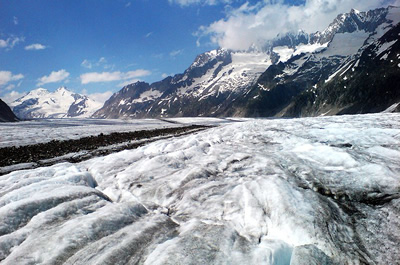Aletsch Glacier in the Swiss Alps is the largest alpine glacier. A remnant of the last Ice Age, which ended about 12,000 years ago, it is located at the confluence of three smaller glaciers in the eastern Bernese Alps.
The glacier is 45 square miles (120 square kilometers) in area and extends for 14 miles (23 kilometers). On average, it is 1 mile (1.5 kilometers) in width.
Aletsch Glacier flows at a rate of 590 feet (180 meters) per year.
At its source, it is about 3,000 feet (900 meters) thick. By the time it reaches the Rhone Valley, it has thinned out to only about 500 feet (150 meters).
The foot of the glacier is about 5,118 feet (1,560 meters) above sea level.
 The Massa River, a tributary of the Rhone River, is made up of meltwater from the glacier.
The Massa River, a tributary of the Rhone River, is made up of meltwater from the glacier.
Because Aletsch Glacier was formed by the merging of three smaller glaciers, two dark stripes, known as medial moraines, run along its surface. These consist of debris that was pushed alongside the smaller glaciers.
Known for its spectacular beauty, the Jungfrau-Aletsch-Bietschhorn region of the Alps, where Aletsch Glacier is located, has striking lakes, U-shaped valleys, horn peaks and curtains of rock - geological features that were formed by glacial activity. This region is a UNESCO World Heritage Site.
In 2008, a 260 foot (80 meter) high suspension bridge was built over Massa Gorge, an immense gorge that was carved out by the glacier over thousands of years.
By studying the glacier scientists have learned more about the history of our planet and its ecosystems. It is an important resource for learning about the effects of climate change.
Aletsch Glacier is known to have been retreating since the middle of the 19th century, but the rate of retreat has increased a great deal over the past several decades.